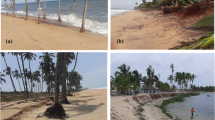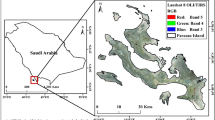Abstract
Vietnam has approximately 5600 km of coastline and is among the countries most vulnerable to future sea level rise (SLR). In terms of risk of inundation and affected population, Vietnam is one of the countries most at risk from climate change (MONRE 2016; Tamura et al. 2019). According to tide gauge readings, mean sea level increased 2.45 mm/year between 1960 and 2014; satellite data indicates a 3.50 ± 0.7 mm/year rise between 1993 and 2014 (MONRE 2016). As sea levels continue to rise, those living in and near coastal areas face a serious threat.
You have full access to this open access chapter, Download chapter PDF
Similar content being viewed by others
Vietnam has approximately 5,600 km of coastline and is among the countries most vulnerable to future sea level rise (SLR). In terms of risk of inundation and affected population, Vietnam is one of the countries most at risk from climate change (MONRE 2016; Tamura et al. 2019). According to tide gauge readings, mean sea level increased 2.45 mm/year between 1960 and 2014; satellite data indicates a 3.50 ± 0.7 mm/year rise between 1993 and 2014 (MONRE 2016). As sea levels continue to rise, those living in and near coastal areas face a serious threat.
Figure C3.1 shows the potentially inundated areas of Vietnam due to SLR in 2100 under the RCP8.5 scenario, as well as the distribution of mangrove forests. The Mekong River Delta (MRD) and Red River Delta were projected to experience considerable inundation because of their low elevations. The total area of the MRD is about 40,000 km2 and was inhabited by nearly 18 million people in 2018. The elevation of coastal areas in the MRD ranges from 0.3–0.7 meters and the length of coastal area is more than 1,300 km. In Vietnam, sea dikes, mainly made of soil, were commonly constructed in the 1980s. Concrete structures of several types have also been put in place in coastal zones. However, the construction techniques used for these structures have tended to be simple and primitive and the barriers are susceptible to collapse (Tamura et al. 2018). Figure C3.2 shows the changes in the coastline at the town of Vinh Chau in Soc Trang Province based on images obtained by Google Earth in January 2006 compared to those taken by a unmanned aerial vehicle (UAV) in November 2015. Many of the mangrove forests have disappeared and areas of the coastline showed extensive erosion at some locations due to a decrease in sediments from upstream river reaches, economic activities, and long-term SLR.
Change in coastlines at the commune of Vinh Chau, Soc Trang (Tamura et al. 2018)
Adaptation measures can reduce the adverse impacts of climate change. There are three main approaches to adapt to the impact of SLR in coastal areas: retreat, accommodation, and protection. For reliable adaptations in the future, it is necessary to examine the effectiveness and cost of coastal protection. This study evaluated the effectiveness of adaptation scenarios in the MRD—one involving dikes only, the other combining dikes and mangrove planting—and estimated their costs. The coastline of the MRD is 1,302 km long and includes 945 km of mangrove forest in estuary areas.
The total population at risk of SLR in the MRD may increase roughly early in this century and then decrease during the rest of twenty-first century under five socio-economic scenarios (Fig. C3.3). Figure C3.4 shows an overview of economic losses due to SLR in the MRD without adaptation under five Shared Socioeconomic Pathways (SSP1-5). The economic damage was estimated by multiplying the inundated area and the value of land.
Total population at risk in the MRD in the twenty-first century (Pham et al. 2020)
Economic damage in MRD in the twenty-first century (Pham et al. 2020)
The study also presents a cost benefit analysis derived from mixing grey and green infrastructures in the MRD to adapt to SLR. It was assumed that the area’s existing earth dikes will be upgraded to a height of 4 m and no mangrove and concrete dikes will be built in the area. Mixing grey and green infrastructures is evaluated for the following four scenarios: (1) A concrete dike system with a height of 4 m is built in areas without mangroves; (2) Mangrove forests can grow in suitable areas; (3) The lifespan of concrete dikes is 100 years; (4) The lifetime of mangrove is 50 years and the growth period of mangrove forests is 10 years before they can perform a protection function.
Table C3.1 compares the effectiveness of mixing grey and green infrastructures with other adaptation options. The benefit of earth dikes in combination with mangrove forests, or mixing grey and green infrastructures, is higher than the benefit from concrete dikes alone. The results also indicate that the benefits of SLR adaptation can exceed the costs required to set up an adaptation system. It is found that combining mangrove forests and dikes can serve as an effective climate change adaptation measure in Vietnam, where the potential inundated area and economic damage may be quite large.
References
MONRE (2016) Climate change and sea level rise scenarios for Viet Nam. Ministry of Natural Resources and Environment
Pham TO, Tamura M, Kumano N, Nguyen Q (2020) Cost-benefit analysis of mixing grey and green infrastructures to adapt to sea level rise in the Vietnam Mekong River Delta. Sustainability 12(24):19
Tamura M, Yasuhara K, Ajima K, Trinh VC, Pham SV (2018) Vulnerability to climate change and Residents’ adaptations in coastal areas of Soc Trang Province, Vietnam. Int J Glob Warm 16(1):102–117
Tamura M, Yotsukuri M, Kumano N, Yokoki H (2019) Global assessment of the effectiveness of adaptation in coastal areas based on RCP/SSP scenarios. Clim Chang 152(3–4):363–377
Author information
Authors and Affiliations
Corresponding author
Editor information
Editors and Affiliations
Rights and permissions
Open Access This chapter is licensed under the terms of the Creative Commons Attribution 4.0 International License (http://creativecommons.org/licenses/by/4.0/), which permits use, sharing, adaptation, distribution and reproduction in any medium or format, as long as you give appropriate credit to the original author(s) and the source, provide a link to the Creative Commons license and indicate if changes were made.
The images or other third party material in this chapter are included in the chapter's Creative Commons license, unless indicated otherwise in a credit line to the material. If material is not included in the chapter's Creative Commons license and your intended use is not permitted by statutory regulation or exceeds the permitted use, you will need to obtain permission directly from the copyright holder.
Copyright information
© 2022 The Author(s)
About this chapter
Cite this chapter
Tamura, M., Pham, O.T. (2022). Mixing Grey and Green Infrastructures for Coastal Adaptation in Vietnam. In: Ito, T., Tamura, M., Kotera, A., Ishikawa-Ishiwata, Y. (eds) Interlocal Adaptations to Climate Change in East and Southeast Asia. SpringerBriefs in Climate Studies. Springer, Cham. https://doi.org/10.1007/978-3-030-81207-2_13
Download citation
DOI: https://doi.org/10.1007/978-3-030-81207-2_13
Published:
Publisher Name: Springer, Cham
Print ISBN: 978-3-030-81206-5
Online ISBN: 978-3-030-81207-2
eBook Packages: Earth and Environmental ScienceEarth and Environmental Science (R0)








